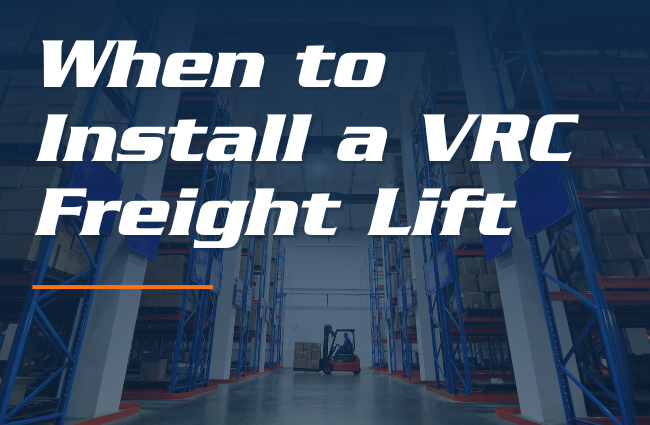We use cookies to make your experience better. To comply with the new e-Privacy directive, we need to ask for your consent to set the cookies. Learn more.
When to Install a VRC Freight Lift at Your Facility
A vertical reciprocating conveyor (VRC) is a type of freight lift that efficiently raises and lowers materials between levels. Importantly, freight lifts are not elevators—they have distinct safety standards (ASME Standard B20.1) and cannot be used to lift human workers. 
That’s a limitation, but it’s also an advantage: Compared with elevators, VRCs are much less expensive to operate. They require fewer inspections, so they’re easier to maintain.
And a custom-designed freight lift can provide a quick return on investment, particularly for facilities with limited floor space. Below, we’ll provide tips for determining whether a VRC will appropriately address your facility’s needs, along with key considerations to keep in mind while purchasing.
VRC Freight Lifts: When to Invest in Material Handling Improvements
VRCs are ideal for improving inventory control and mezzanine access, and they’re frequently installed in warehouses and storage facilities. With that said, the potential applications are virtually endless.
For example, VRCs can support warehouse automation by transporting automated guided vehicles (AGVs) and robots. They can move heavy-duty loads, such as cars at multi-story dealerships—but they’re also an appropriate solution for moving small materials up to a mezzanine via a single-cabin freight lift.
Put simply, if your team needs to regularly move materials between levels—but not transport workers—a VRC makes sense.
However, if workers must also move between floors to handle products, a freight elevator is a more appropriate option. To learn more about the differences between these systems, read: Vertical Reciprocating Conveyors (VRCs) Vs. Freight Elevators.
VRC Freight Lifts: Questions to Consider
If you’re trying to determine whether a VRC will improve operations at your facility, ask yourself a few questions:
- How often do we transport equipment or products between floors? If vertical storage is rarely accessed, forklifts may be a more appropriate option.
- Is my facility using floor space optimally? If not, mezzanine flooring systems can provide a cost-effective solution—but only when complemented with appropriate MHE.
- Will installing freight lifts reduce the need for lift trucks? This can be an excellent secondary benefit to VRC installation: VRCs work well as forklift replacements, and can make your work environment much more efficient (and safer).
- How can VRCs be integrated with other systems? Customized VRCs can feed products to conveyors, hoppers, and other equipment, dramatically improving workflow.
To read several examples of VRC lift applications, read: Vertical Reciprocating Conveyors: 5 Sample Use Cases
Customizing VRC Freight Lifts for Your Facility
The efficient vertical transportation of goods is crucial for optimizing operations. If you need to grow your facility’s operational capacity, a VRC can be a cost-effective solution—but the system must be appropriately designed and installed to deliver its full benefits. That’s particularly important when lifts will handle loads with unconventional sizes or dimensions, and for VRC systems that integrate with other equipment.
The BHS engineering team can help you develop VRC systems for virtually any application. By drawing on decades of experience, we develop VRC systems that meet our clients' needs and fit into their existing workflows from day one.
Following VRC installation, we provide ongoing support and technical help. Our goal is to help warehouses, storage facilities, and other operations find better paths to productivity—while improving safety and ergonomics for workers.
To get started, contact BHS by taking one of the following steps:
- Request a quote for a VRC system.
- Call the BHS sales team at800.247.9500.
- Send us an email at sales@bhs1.com.
